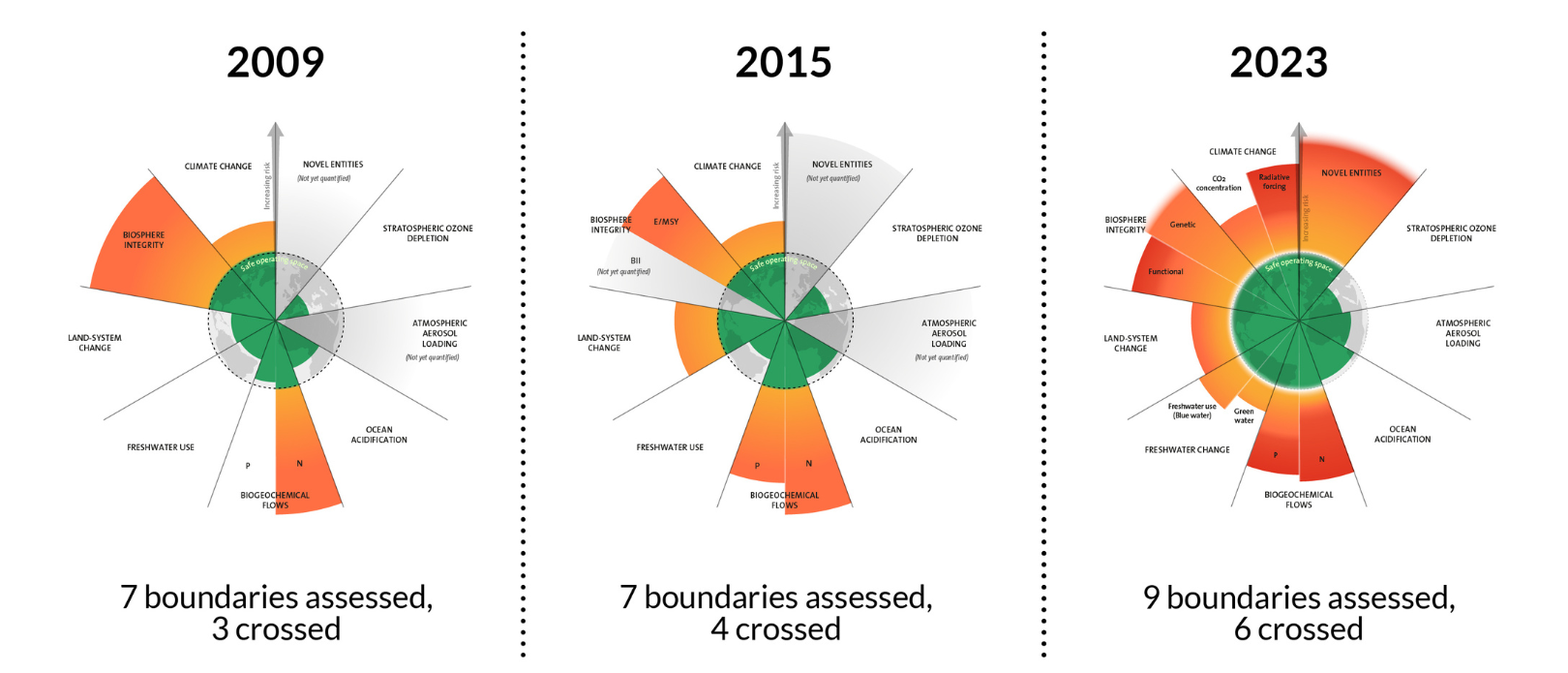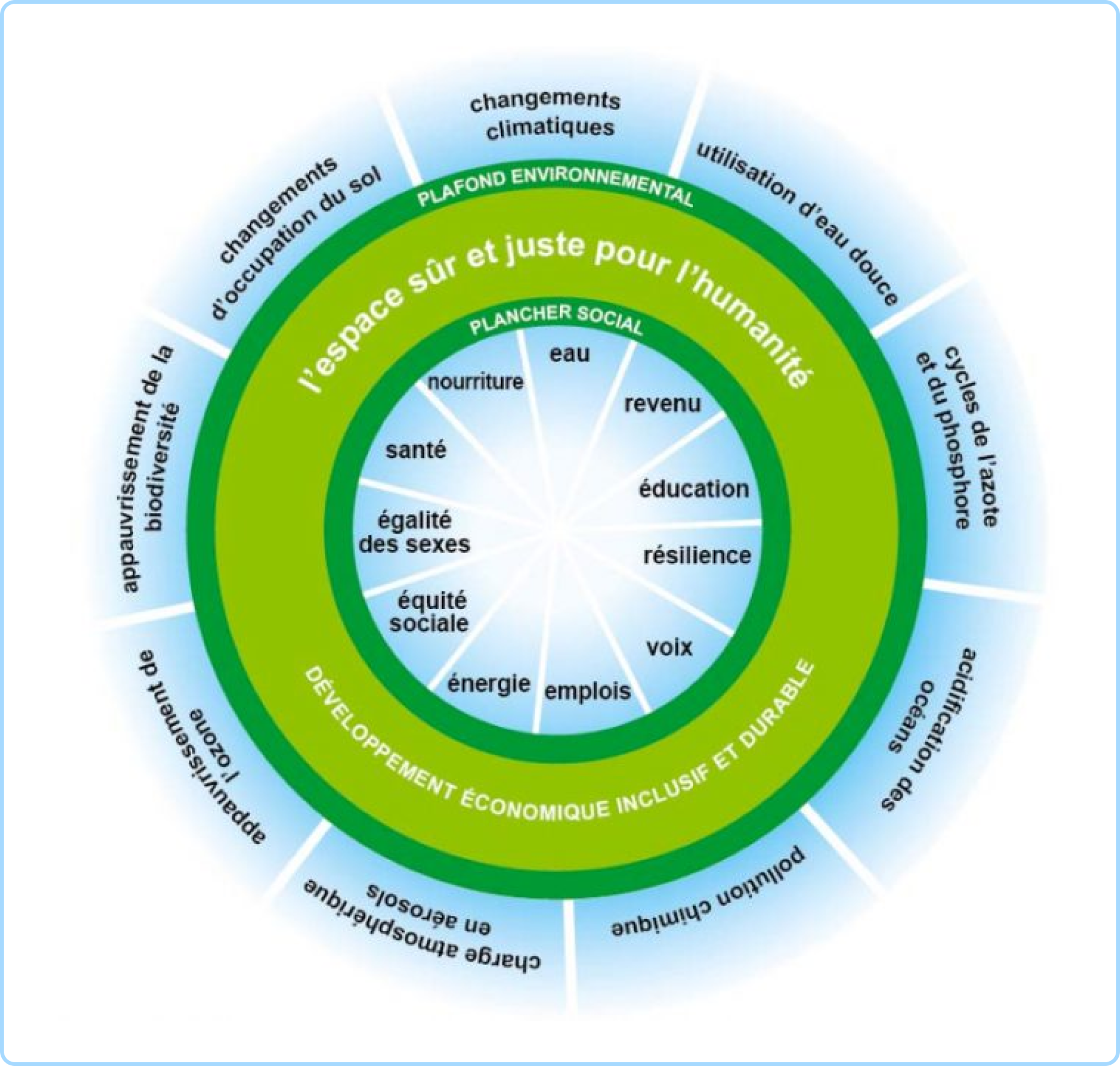At the heart of scientific, political and societal debates, the concept of planetary limits defines environmental thresholds that must not be exceeded to preserve a safe living space for humanity. It is a conceptual framework, a scientific reading grid, which today serves as a reference for understanding the interactions between human activities and the planet's overall equilibrium.
Every year, the day of overshoot draws nearer. It marks the moment when we have consumed all the natural resources that the Earth is capable of renewing in one year. A strong signal to reflect on planetary limits and the need to preserve a "safe operating space for humanity".
Planetary limits: the origins of the concept
The concept of planetary limits stems from an international study carried out in 2009 in collaboration with the Stockholm Resilience Center. Entitled A safe operating space for Humanityit was conducted by a group of 28 international scientists, under the direction of Johan Rockström, former director of the SRC (the Swedish researcher himself explains the concept in a pedagogical way in this 18-minute TED video, seen over 2 million times).
This scientific work is based on the fact that the earth's equilibrium over the last ten thousand years has provided very favorable living conditions for the development of humankind. However, since the beginning of the Anthropocene, and particularly in recent decades, human activities have had such an impact on geology and ecosystems that they are destabilizing the space in which we live and could render the planet uninhabitable. The question is: what are the thresholds we must not exceed?
The nine planetary limits and the causes of their degradation
The study sets nine limits that must not be crossed if the Earth's ecosystem is to continue to function in a way that is sustainable. These different limits inevitably interact in important ways.
1. Climate change
An energy and climate imbalance, it is due to the accumulation of greenhouse gases (mainly CO₂), mainly emitted by human activities such as fossil fuel combustion and deforestation
2. Erosion of biodiversity
Destruction and artificialization of natural environments, overexploitation of resources (cf. the day of overshoot), climate change, pollution, introduction of invasive exotic species...
3. Nitrogen and phosphorus cycle
Modern agriculture (fertilizers and livestock), inadequate wastewater treatment and urbanization are disrupting the biogeochemical cycles of nitrogen and phosphorus, exceeding the biosphere's natural regulating capacities.
The massive input of nitrogen and phosphorus promotes excessive algal blooms in lakes, rivers and coastal areas (eutrophication). This depletes dissolved oxygen in the water, leading to a loss of aquatic biodiversity. Natural cycles are altered, affecting plant growth and the capacity of soils to absorb and return these nutrients, altering the balance of terrestrial ecosystems. Finally, excess nitrogen promotes the production of nitrous oxide (N₂O), a powerful greenhouse gas, accelerating climate change.
4. Change of land use
The combination of food demand, economic growth, urban expansion and agricultural innovation is having a major impact on ecosystems, biodiversity and climate (deforestation, soil sealing, loss of natural areas, etc.).
5. Ocean acidification
Seas and oceans absorb a portion of the carbon dioxide (CO2) produced by human activities. This dissolved CO2 reacts with seawater to form carbonic acid, which lowers the pH of the water, making the oceans more acidic. Eutrophication linked to coastal overabundance of nitrogen and phosphorus can accentuate this phenomenon locally.
6. Freshwater cycle
Climate change, urbanization and land artificialisation, overexploitation, pollution, deforestation and changes in land use, saltwater intrusion in coastal areas are all factors that disrupt the freshwater cycle.
7. Stratospheric ozone layer
Its degradation is mainly linked to the emission of halogenated compounds. Chemicals accumulated in the atmosphere are transported to the stratosphere, where they are transformed by photochemical reactions, producing chlorinated or brominated derivatives that are highly active on ozone.
8. Atmospheric aerosols
Airborne particles of natural (volcanoes, dust, forest fires...) and human origin: the combustion of coal, oil, gas and industrial emissions generate sulfates, nitrates and soot carbon, which modify the composition of the atmosphere. They play a key role in modulating climate and the hydrological cycle by affecting sunlight and cloud formation.
9. New entities (pollutants)
All chemical substances, materials and artificial agents in the environment: industrial chemicals (plastics, solvents, pesticides, etc.), heavy metals (from mining or fossil fuel combustion, for example), fine particles, SOx, Nox, VOCs... Their accumulation and long-term effects are still poorly understood.
Exceeding planetary limits and concrete risks
The concept of planetary limits is evolving as our understanding of the phenomena evolves. According to information dated June 2025, 7 of the 9 limits have now been exceeded (ocean acidification, due mainly to CO2 emissions, is the seventh limit to have been exceeded. This new threshold was crossed several years ago).

Exceeding planetary limits calls into question the resilience of ecosystems and the natural cycles of water, carbon, nitrogen, phosphorus... and threatens the stable conditions that have enabled our development on Earth.
Each limit crossed increases the probability of reaching critical ecological thresholds, beyond which natural systems can tip over into very different states, sometimes impossible to reverse (collapse of certain ecosystems, irreversible melting of icecaps, disappearance of species...). Because of their interactions, exceeding one of them can worsen the situation for the others.
Ecosystems regulate climate, purify water, maintain soil fertility and provide services essential to human survival. Their degradation jeopardizes food security, freshwater availability, health and human well-being.
Integrating planetary limits: an imperative for our collective future
It's because companies are making a definite contribution to crossing these limits that global organizations such as the UN Global Compact, with the establishment of the SDGs, bodies such as the European Union with the CSRD, or countries such as Japan, China, Egypt, the United Arab Emirates and others are inviting or compelling, depending on the case, greater transparency on the sustainability of business models. Consumers and investors now expect strong commitments from companies.
The concept of planetary limits needs to be understood by businesses, public decision-makers and citizens alike, as it provides a structuring scientific framework for rethinking and guiding more responsible and sustainable strategies. They require us to innovate in order to reimagine our economic models, and guarantee - not only the long-term survival of organizations, but also the habitability of the planet for future generations.
The Donut Theory: how to act within a framework of global resilience
The Donut Theory, the economy of tomorrow in 7 key principles by British economist Kate Raworth, first set out in an Oxfam report in 2012, throws out GDP and proposes a new framework for assessing economic prosperity: satisfying basic human needs without exceeding the planet's capacity.
- Social floor: At the center of the donut are essential needs (food, health, housing, education, access to water, equity, etc.). If people don't reach this minimum level, they fall into the "hole" of the donut, i.e. into a situation of deprivation or social exclusion.
- Environmental ceiling: The outer ring of the doughnut represents the 9 planetary limits that must not be crossed to preserve ecological equilibrium. To go beyond this circle is to risk major ecological crises.

The ideal zone - the safe and just space for humanity - therefore lies between these two circles, where everyone's needs are met without exceeding the Earth's ecological limits.
Exceeding planetary limits could lead to profound environmental changes, jeopardizing the stability of vital systems and the viability of a planet conducive to human life. But by integrating them into their strategy, companies and public authorities can identify and anticipate the major ecological risks (resource depletion, loss of biodiversity, climate disruption, water availability) that threaten economic activities and the stability of society.
Will you be one of those companies that have succeeded in securing their future by seizing on these limits as a lever for sustainable transformation and a competitive advantage?
Further information:
- "The strongest constraints to which companies are subject are not their voluntary commitments but planetary limits"Le Monde, article by Hélène Bernicot Managing Director of Crédit Mutuel Arkéa and Guillaume Desnoës Co-founder of Alenvi, 07/11/2023
- "What are ecosystem services and what types are they?"Dr, Emily Greenfield, SigmaEarth, 29/12/2023
Sources :
- "A safe operating space for humanity",Rockström, J., Steffen, W., Noone, K., Persson, Å., Chapin, III, F.S., Lambin, E., Lenton, T.M., Scheffer, M., Folke, C., Schellnhuber, H., Nykvist, B., De Wit, C.A., Hughes, T., van der Leeuw, S., Rodhe, H., Sörlin, S., Snyder, P.K., Costanza, R., Svedin, U., Falkenmark, M., Karlberg, L., Corell, R.W., Fabry, V.J., Hansen, J., Walker, B.H., Liverman, D., Richardson, K., Crutzen, C., Foley. J. (2009), Stockholm Resilience center, 2009/09/23
- "France facing the 9 planetary limits"Ministry of Ecology, 06/10/2023
- "Popularized summary of the 6th IPCC report"The Shift Project, 09/05/2023


.svg)



